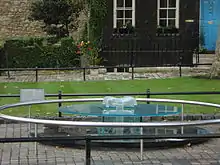Tower Green
Tower Green is a space within the Tower of London, a royal castle in London, where two English Queens consort and several other British nobles were executed by beheading. It was considered more dignified for nobility to be executed away from spectators, and Queens Anne Boleyn, Catherine Howard and Lady Jane Grey were among the nobility beheaded here. Queen Victoria asked for information on the exact location where the executions took place and had some granite paving laid to mark the spot. However, it is unclear whether the location is indeed correct because other sources place it on the current parade ground between the White Tower and the entrance to the current Waterloo Barracks.

Location

Tower Green is an open space located south of the Chapel Royal of St. Peter ad Vincula. Beheading in the privacy of the Tower Green was considered a privilege of rank; the executed were spared insults from jeering crowds, and the monarch was spared bad publicity. Other prisoners in the tower were executed in public on Tower Hill, just outside the fortress, or at Tyburn on the other side of the city. In the middle of the green is a small square plot paved with granite, which shows the site commonly believed to be the spot on which stood the scaffold on which private executions took place. The granite paving was specially created by order of Queen Victoria.[1][2]
There is dispute that the memorial site is actually the scaffold site. It appears that there are sources that indicate that the site of the current memorial is merely a spot incorrectly pointed out to Queen Victoria, by an unknowing Yeoman Warder, when she inquired about the scaffold site during a visit to the Tower. Other sources describe Anne Boleyn's final walk to the scaffold, at a location on the current parade ground, between the White Tower and the entrance to the current Waterloo Barracks (not built until 1845).
History
.jpg.webp)
During the Middle Ages, the area was used as a burial ground. As a result of relaying the 19th century granite sett stones, shallow excavations of the foundations revealed remains of a building that sat on that site. Historic plans of the Tower of London show a building at the site of the Tower Green. It was demolished in 1684, but was rebuilt in 1685. It was removed once again soon thereafter. It appears that the building was used at the time as a guardhouse for the predecessors of the Yeomen Warders.[3] The executions at the Tower Green were done inside this building to maintain the privacy of the nobles.[4]
Executions
The following nobles are known to have been executed on the Tower Green:
- William Hastings, 1st Baron Hastings, by order of Richard, Duke of Gloucester, in 1483.[1]
- Queen Anne Boleyn, second wife of King Henry VIII, 19 May 1536.[5]
- Margaret, Countess of Salisbury, the last of the Plantagenet dynasty on 27 May 1541.[6]
- Queen Catherine Howard, fifth wife of Henry VIII, by a bill of attainder on 13 February 1542.[7]
- Jane Boleyn, Viscountess Rochford, by order of Henry VIII on 13 February 1542.[8]
- Lady Jane Grey, the "Nine Days Queen", wife of Lord Guildford Dudley, by order of a special commission for High treason, on 12 February 1554.[9]
- Robert Devereux, 2nd Earl of Essex for treason on 25 February 1601.[10]
Each of these individuals was beheaded with an axe, except for Anne Boleyn who was beheaded with a sword. The bodies of all seven were buried in the Chapel of St Peter ad Vincula.[1]
In addition to the seven listed above, there are three additional names listed on the memorial at Tower Green: Malcolm Macpherson, Samuel Macpherson and Farquhar Shaw. They were soldiers of the Black Watch Regiment from the Scottish Highlands who were convicted of mutiny, and were executed at the Tower on 19 July 1743 by a twelve-man firing squad composed of their fellow soldiers.
See also
References
- Parnell, Geoffrey; Lapper, Ivan (2000). The Tower of London: A 2000 Year History (Landmarks in History). Osprey Publishing (UK). ISBN 1-84176-170-2.
- Staines, Joe; Rob Humphreys; Judith Bamber; Sean Bidder; Charles Campion; Jane Czyzselska; Val Humphreys (2003). The Rough Guide to London (Rough Guide London). Rough Guides Limited. ISBN 1-84353-093-7.
- "Evidence of Tudor and Jacobean Life uncovered at the Tower of London". Retrieved 13 February 2008.
- ParnellG (1979). "Observations on Tower Green". London Archaeologist. 3 (12): 320–326.
- Denny, Joanna (2006). Anne Boleyn: A New Life of England's Tragic Queen. Cambridge, Mass: Perseus Books Group. pp. 317. ISBN 0-306-81474-9.
- Pierce, Hazel (2003). Margaret Pole, Countess of Salisbury, 1473-1541: loyalty, lineage and leadership. Cardiff: University of Wales Press. ISBN 0-7083-1783-9.
- Weir, Alison (1991). The six wives of Henry VIII. New York: Grove Weidenfeld. pp. 475. ISBN 0-8021-3683-4.
- Julia Fox (2007). Jane Boleyn: The True Story of the Infamous Lady Rochford. [New York: Ballantine Books. ISBN 0-345-48541-6.
- Plowden, Alison (2003). Lady Jane Grey: nine days queen. Stroud: Sutton. ISBN 0-7509-2816-6.
- Lacey, Robert (2001). Phoenix: Robert, Earl of Essex: An Elizabethan Icarus. London: Phoenix Press. ISBN 1-84212-285-1.
| Wikimedia Commons has media related to Tower Green. |

.svg.png.webp)